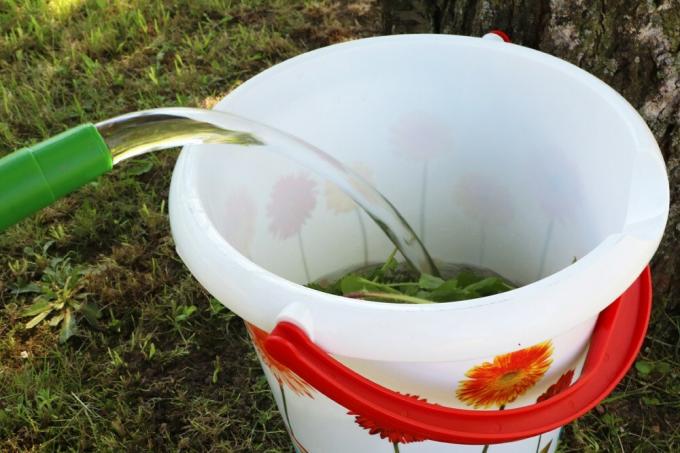
table of contents
- Recognize nettles
- Combat
- Precautions
- Individual plants
- New planting of beds
- mowing
- Contain nettles
- Getting rid of nettles for good
While nettles are useful plants, they are not very welcome in the garden. They spread through underground runners in all accessible and inaccessible places and displace other plants there. In addition, nettles are difficult to get rid of. The completely green plants also do not have any particular ornamental value. Nettle can be controlled with chemical means, but not every gardener likes to do this. Instead, people prefer to resort to options that are natural.
Recognize nettles
Identifying the large or small nettle (Urtica dioica and Urtica urens) is easy. The plants grow upright, the stems and leaves have innumerable stinging hairs and should not be touched without thick gloves. The plants can be between 50 and 100 cm tall. Individual specimens grow even taller. The nettle is a typical pointer plant for nitrogenous soils. That means, where the nettle grows well, the soil is very rich in nutrients and well suited for planting vegetables, for example. Stinging nettles reproduce mainly via root runners, the plexus can take on very large dimensions and be richly branched. It will then be difficult to get rid of the weeds easily.
Combat
If you want to remove nettle plants naturally, then you should definitely consider a sustainable measure. Simply pulling up the plant will ensure that it has disappeared for the moment, but the roots will soon sprout again. Fighting in this way can go on forever.
Precautions
Some people are insensitive to that Stinging hairsbut most prefer to be in as little contact with it as possible. Although it cannot be seen on the plant, the stinging hairs are very firm and can penetrate through light gardening gloves and clothing. So it is important to wear long clothes made of sturdy fabric and rubber gloves, especially with larger nettles. When the roots are exposed, the plants can also be pulled out of the earth using them, they have no stinging hairs.

Individual plants
If you are fighting individual plants, for example in the bed or in the lawn, the easiest way to remove them is with a weed cutter. The roots do not grow very deep, as in the case of dandelions, but with a large number of smaller runners, all of which must also be removed. The nettles are removed as soon as they become visible in spring.
tip: If you do not have gardening gloves at hand, you can proceed as follows: Kick the nettle aside with your foot so that the root area is exposed. Loosen the roots with a three-pronged garden hoe and then carefully pull the plant out of the ground.
New planting of beds
If you want to create new bedding areas in the garden, they should be as free from weeds as possible. Especially from annoying weeds like the nettle. There are two ways to control nettles sustainably before creating new beds.
- Mulching
- Dig up
Mulching
For the Mulching the entire area is mowed as low as possible. You can leave the cuttings on the surface or compost them. After that, you should lay black mulch film directly on the floor. Make sure that you really cover the entire area. You can also mulch with natural material from the garden, provided you spread it in the soil thick enough. The mulch material must remain on the surface until the last plant under the mulch cover has died. You can then clean the area from the roots with a rake or rake.
Dig up
Digging up the area is more time-consuming and sweaty. All existing weeds, including nettles, can be removed with the roots. Careful work is worthwhile as it minimizes the number of regrowing weeds. You can use a spade or a digging fork for digging. With the Urtica, the digging fork is more suitable because it does not cut the roots. They can be pulled out of the earth when loosened. Digging works best on a cloudy day with moist, but not wet, soil.
mowing
In garden areas that are not to be used as beds, it is easier to destroy the nettles by mowing them frequently. To do this, always mow the nettles when they have grown a few centimeters. After a while, the plants lose their strength and die. However, you will need a lot of patience and time for this measure. In addition, the clippings should not remain on the surface, it would supply the nettle roots with new nutrients. It makes more sense to use the area to lose weight, and so displace the nettle with other plants.
Contain nettles
Since nettles also have good sides, it can be worthwhile to merely contain them in some places in the garden and not to destroy them entirely. Urtica dioica and Urtica urens serve as food for many caterpillars, they can also be prepared as a salad or vegetable and a Manure from nettles strengthens and fertilizes the garden plants.

It is important to mow the nettles regularly in the places where they are allowed to grow so that they can grow do not seed and dig a root barrier around the area so that it does not spread out spread.
Getting rid of nettles for good
Nettles are very resilient, simply throwing them on top of the compost after mowing or digging can cause them to spread further from there.
Ways to prevent this from happening:
- Dry the nettle plants and their roots in the sun
- Prepare liquid manure with it
- Bring them into the garden area where they can grow undisturbed
- Dispose of in organic waste, household waste or a public composting facility

